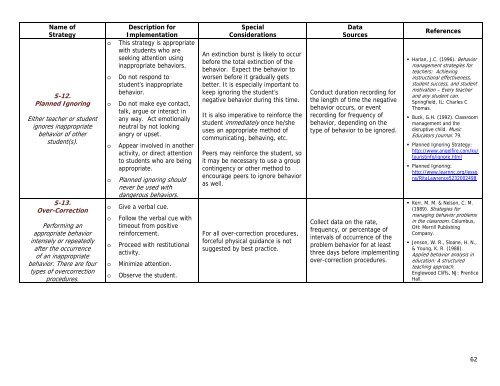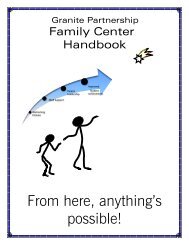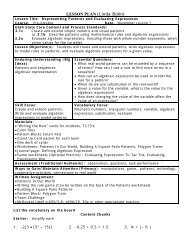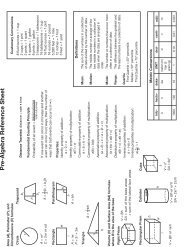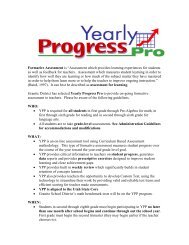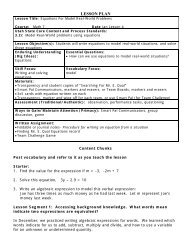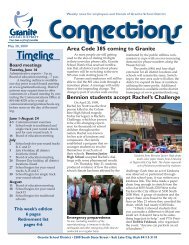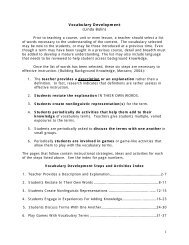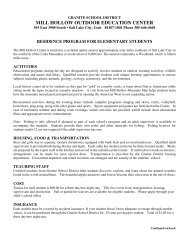Utah's Least Restrictive Behavioral Interventions Guidelines
Utah's Least Restrictive Behavioral Interventions Guidelines
Utah's Least Restrictive Behavioral Interventions Guidelines
You also want an ePaper? Increase the reach of your titles
YUMPU automatically turns print PDFs into web optimized ePapers that Google loves.
Name of<br />
Strategy<br />
S-12.<br />
Planned Ignoring<br />
Either teacher or student<br />
ignores inappropriate<br />
behavior of other<br />
student(s).<br />
S-13.<br />
Over-Correction<br />
Performing an<br />
appropriate behavior<br />
intensely or repeatedly<br />
after the occurrence<br />
of an inappropriate<br />
behavior. There are four<br />
types of overcorrection<br />
procedures.<br />
o<br />
o<br />
o<br />
o<br />
o<br />
o<br />
o<br />
o<br />
o<br />
o<br />
Description for<br />
Implementation<br />
This strategy is appropriate<br />
with students who are<br />
seeking attention using<br />
inappropriate behaviors.<br />
Do not respond to<br />
student’s inappropriate<br />
behavior.<br />
Do not make eye contact,<br />
talk, argue or interact in<br />
any way. Act emotionally<br />
neutral by not looking<br />
angry or upset.<br />
Appear involved in another<br />
activity, or direct attention<br />
to students who are being<br />
appropriate.<br />
Planned ignoring should<br />
never be used with<br />
dangerous behaviors.<br />
Give a verbal cue.<br />
Follow the verbal cue with<br />
timeout from positive<br />
reinforcement.<br />
Proceed with restitutional<br />
activity.<br />
Minimize attention.<br />
Observe the student.<br />
Special<br />
Considerations<br />
An extinction burst is likely to occur<br />
before the total extinction of the<br />
behavior. Expect the behavior to<br />
worsen before it gradually gets<br />
better. It is especially important to<br />
keep ignoring the student’s<br />
negative behavior during this time.<br />
It is also imperative to reinforce the<br />
student immediately once he/she<br />
uses an appropriate method of<br />
communicating, behaving, etc.<br />
Peers may reinforce the student, so<br />
it may be necessary to use a group<br />
contingency or other method to<br />
encourage peers to ignore behavior<br />
as well.<br />
For all over-correction procedures,<br />
forceful physical guidance is not<br />
suggested by best practice.<br />
Data<br />
Sources<br />
Conduct duration recording for<br />
the length of time the negative<br />
behavior occurs, or event<br />
recording for frequency of<br />
behavior, depending on the<br />
type of behavior to be ignored.<br />
Collect data on the rate,<br />
frequency, or percentage of<br />
intervals of occurrence of the<br />
problem behavior for at least<br />
three days before implementing<br />
over-correction procedures.<br />
References<br />
• Harlan, J.C. (1996). Behavior<br />
management strategies for<br />
teachers: Achieving<br />
instructional effectiveness,<br />
student success, and student<br />
motivation – Every teacher<br />
and any student can.<br />
Springfield, IL: Charles C<br />
Thomas.<br />
• Buck, G.H. (1992). Classroom<br />
management and the<br />
disruptive child. Music<br />
Educators Journal. 79.<br />
• Planned Ignoring Strategy:<br />
http://www.angelfire.com/ky/<br />
touristinfo/ignore.html<br />
• Planned Ignoring:<br />
http://www.learnnc.org/lesso<br />
ns/RitaLawrence5232002498<br />
• Kerr, M. M. & Nelson, C. M.<br />
(1989). Strategies for<br />
managing behavior problems<br />
in the classroom. Columbus,<br />
OH: Merrill Publishing<br />
Company.<br />
• Jenson, W. R., Sloane, H. N.,<br />
& Young, K. R. (1988).<br />
Applied behavior analysis in<br />
education: A structured<br />
teaching approach.<br />
Englewood Cliffs, NJ: Prentice<br />
Hall.<br />
62


